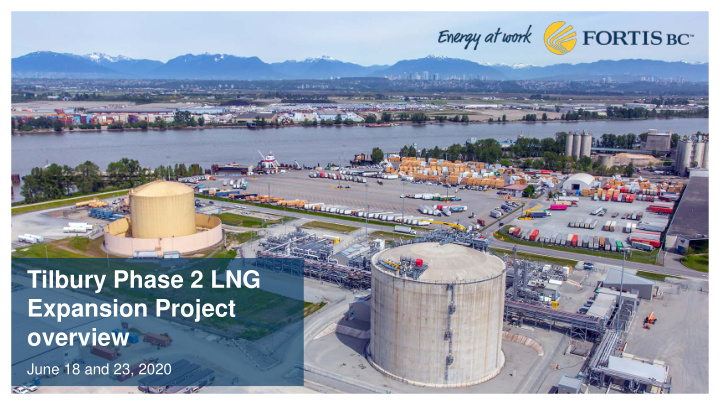



Tilbury Phase 2 LNG Expansion Project overview June 18 and 23, 2020 1
Presenters Courtney Hodson, Todd Smith, P.Eng. Senior Manager, Community Relations Manager Business Development & Tech Assessment 2
FortisBC overview • Canadian-owned, B.C. based • More than 2,400 employees • Diversified energy supplier of natural gas, hydroelectricity, propane and thermal energy • 1.2 million customers 3
30BY30 and our Clean Growth Pathway Energy efficiency Renewable Global LNG Zero and Natural Gas low carbon transportation 4
What is LNG? 5
Lowering emissions with LNG By connecting Tilbury to BC’s power grid, we’re producing LNG with among the lowest carbon intensity in the world LNG from Tilbury can reduce greenhouse gas emissions by up to 50% for industrial customers switching from coal for energy. LNG from Tilbury can reduce greenhouse gas emissions from ships by up to 21% and reduce particulate matter by up to 99% 6
Tilbury LNG overview • In operation since 1971 • Producing LNG for transport customers since 2009 • Producing LNG for overseas customers since 2017 • Storage and liquefaction expansion commissioned in 2018 7
Indigenous and Stakeholder engagement FortisBC has been consulting with municipalities, provincial and federal governments, Indigenous groups, the public and other parties on the proposed Tilbury LNG facility since 2012. Engagement Principles • Timely and relevant updates • Solicit and incorporate feedback • Understand expectations and preferences • Accessibility Changing Realities • COVID-19 • Extensions • Virtual engagement 8
Tilbury Phase 2 Project overview 9
Phase 2 expansion objectives Improve gas system resiliency Grow marine use and exports for BC LNG 10
Phase 2 expansion components LNG storage tank: Up to 162,000 cubic meters (approx. 4 petajoules) LNG production: Up to 11,000 tonnes per day (~3.5 million tonnes per annum) 11
Ancillary components Natural gas Supporting receiving infrastructure •Existing FortisBC •Permanent facilities pipelines and right of including way will be used to administrative, bring natural gas to the electrical, chemical Project site. storage and water systems •Additional distribution infrastructure will be •Temporary needed on site construction components 12
Preliminary Phase 2 expansion layout 13
Preliminary Project Schedule Task / Milestone Timing Submit IPD and Engagement Plan February 2020 COVID-19 extension request 60 days (before start of Public Comment) Submit Detailed Project Description Q4 2020 Submit draft Assessment Application Q2 2021 Submit final Assessment Application Q3/Q4 2021 Synchronous/concurrent Permitting Late 2021 and 2022 Anticipated EA Certificate/Approval Q1/Q2 2022 Begin Final Engineering and Construction 2022 LNG Storage Tank In-Service 2024/25 Phase 2 Liquefaction In-Service 2024 to 2028 14
Physical Environment • Site located between Fraser River and Tilbury Slough • The site is drained by a series of drainage ditches • A dyke maintained by the City of Delta is between the Fraser River and the site • Construction will occur primarily in Dyke upland areas away from river and slough except for use and potential upgrades of a temporary construction jetty Existing Jetty Existing Jetty 15
Biological Environment • Most vegetation was removed during historical site development • Wildlife habitat, water features and fish habitat are limited • A small, wetland with amphibian habitat is present on the site • Fish rearing habitat is present in riparian area next to the site • Fraser River estuary is known to support 78 species of fish • Consideration for riparian vegetation, fish and wildlife habitat will be required for use and potential upgrades to the temporary construction jetty 16
Atmospheric Environment • Short-term increase in noise, light, dust, and air emissions is expected during construction • Noise, air quality and greenhouse gas modelling will determine potential effects during operations • Noise and light impacts will be considered during design • Equipment selection will consider air and greenhouse gas emissions to comply with 30BY30 target • Metro Vancouver Air Permit will also be required 17
Economic, Social, Heritage and Health • Wide range of economic benefits anticipated • Increase in local traffic expected during construction • Socio-economic effects on housing, infrastructure and services will be evaluated • Additional archaeological investigations are underway • Health effects could include short-term increases in noise, air emissions and dust during construction • Noise and air quality assessments will be conducted to determine potential health effects during operations 18
Visual Quality • Site is in an industrial area • Visible from Fraser River and other areas within Delta and Richmond • New buildings will be similar in design to existing • Building design and placement of project components is in progress 19 Rendering of potential full buildout of Phase 1 and Phase 2 expansions
Facility safety • Double-walled steel storage tank • Spill containment systems • On-site fire control • Automatic and manual shutdown systems 20
Project benefits • Hundreds of jobs during construction • 110 long-term jobs during project operation • Spinoff economic benefits for local businesses in construction, engineering and marine • Local and Indigenous training opportunities • Additional tax revenue for Delta, provincial government 21
Thank you For further information, Find FortisBC at: please contact: Fortisbc.com Tilbury project line: 1-855-576-7133 Tilbury.Info@fortisbc.com 604-676-7000 TalkingEnergy.ca/TilburyPhase2
Recommend
More recommend